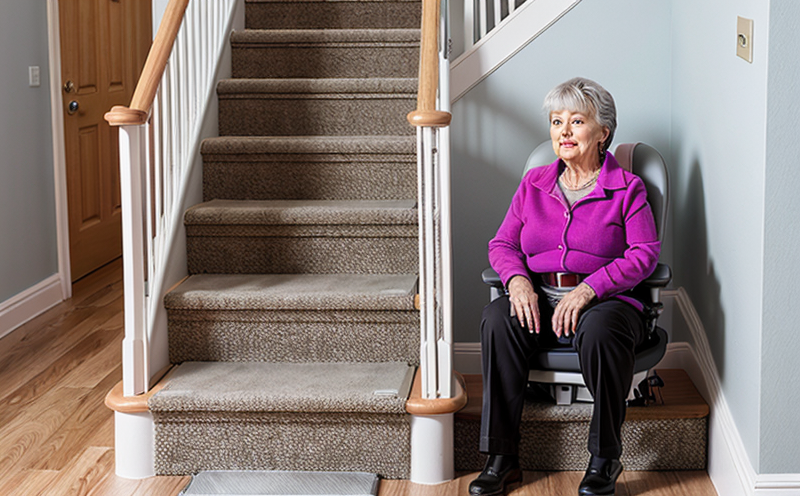Stair lift inspection
The inspection of stair lifts is a critical component in ensuring public safety and compliance with industry standards. Stair lifts are essential mobility aids that assist individuals with disabilities or elderly people to navigate their homes safely. The primary objective of this inspection is to verify the integrity, functionality, and safety features of these devices.
Stair lift inspections typically cover a range of tests including load-bearing capacity checks, electrical system evaluations, control panel assessments, handrail strength verification, and overall structural stability analysis. Compliance with international standards such as ANSI/RESNA A65.1 is essential to ensure that the stair lifts meet strict safety requirements.
The inspection process begins with a thorough review of the device's technical documentation provided by the manufacturer. This includes understanding the design specifications, intended use, and any specific warnings or limitations. Following this, the inspector performs visual inspections focusing on visible signs of wear and tear, corrosion, and damage. These observations are crucial in identifying potential hazards that could compromise safety.
Load-bearing capacity tests involve applying calibrated weights to simulate different user profiles. This helps ensure that the stair lift can safely support its intended load without failure. Electrical system evaluations focus on checking insulation resistance, grounding continuity, and overall electrical integrity using specialized equipment like multimeters and capacitance testers. Control panel assessments are conducted by simulating various operational scenarios to verify proper function.
Handrail strength verification is performed by applying standardized forces according to ASME A17.1 requirements to ensure they can withstand expected usage pressures safely. Structural stability analysis involves examining the frame, mounting brackets, and other structural components for any signs of deformation or loosening that might indicate instability under load conditions.
After completing all inspections, detailed reports are generated summarizing findings along with recommendations for necessary repairs or adjustments to maintain compliance. These reports serve as important documentation for clients ensuring they understand the current state of their equipment and what steps need to be taken moving forward.
To summarize, stair lift inspection plays an indispensable role in maintaining public safety by identifying potential risks early on before they become serious issues. By adhering strictly to recognized standards and guidelines during this process, we can help guarantee that users have access to reliable and safe mobility solutions within their homes or communities.
Quality and Reliability Assurance
- Conduct thorough visual inspections focusing on visible signs of wear and tear, corrosion, and damage.
- Perform load-bearing capacity tests by applying calibrated weights to simulate different user profiles.
- Evaluate electrical systems checking insulation resistance, grounding continuity, and overall electrical integrity using specialized equipment like multimeters and capacitance testers.
- Simulate various operational scenarios on control panels to verify proper function.
The inspection process also includes handrail strength verification by applying standardized forces according to ASME A17.1 requirements ensuring they can withstand expected usage pressures safely. Structural stability analysis examines the frame, mounting brackets, and other structural components for any signs of deformation or loosening that might indicate instability under load conditions.
These rigorous quality checks are designed not only to meet regulatory requirements but also to exceed them by providing additional layers of safety and reliability. Through meticulous attention to detail throughout every stage of the inspection process, we ensure that stair lifts continue operating at peak performance levels while remaining completely safe for use by all intended users.
Environmental and Sustainability Contributions
The environmental impact of stair lift inspections is minimal due to the nature of the work involved. Most inspections are conducted on-site, reducing the need for extensive transportation which helps minimize carbon emissions associated with travel. Additionally, by ensuring that existing equipment continues to operate safely and effectively for longer periods, fewer replacements or repairs are needed over time.
Furthermore, adhering strictly to recognized standards and guidelines during this process ensures that users have access to reliable and safe mobility solutions within their homes or communities. This reduces the need for alternative forms of transportation such as wheelchairs or public transit which can be more resource-intensive in terms of production and disposal processes.
By promoting regular maintenance practices through thorough inspections, we encourage responsible use of resources by prolonging the life cycle of each device. Such efforts contribute positively towards sustainability goals by minimizing waste generation associated with premature obsolescence. Overall, these proactive measures help foster a more sustainable approach to mobility assistance while enhancing public safety standards.
Use Cases and Application Examples
- In residential settings where elderly individuals or those with limited mobility require safe navigation between floors.
- Within multi-story buildings that serve as community centers, hospitals, schools, or other public facilities to ensure compliance with accessibility laws.
- In private homes equipped with stair lifts for convenience and safety during daily activities like shopping trips or visits from friends and family members.
The inspection process can also be applied in commercial environments such as hotels or retirement communities where guests or residents may benefit from regular assessments to maintain optimal functionality. By prioritizing these inspections, facilities can ensure compliance with relevant regulations while enhancing user experience through reliable performance and enhanced safety features.





